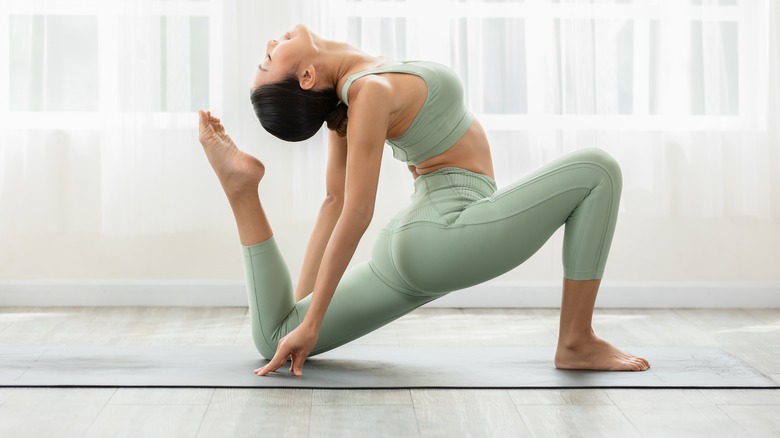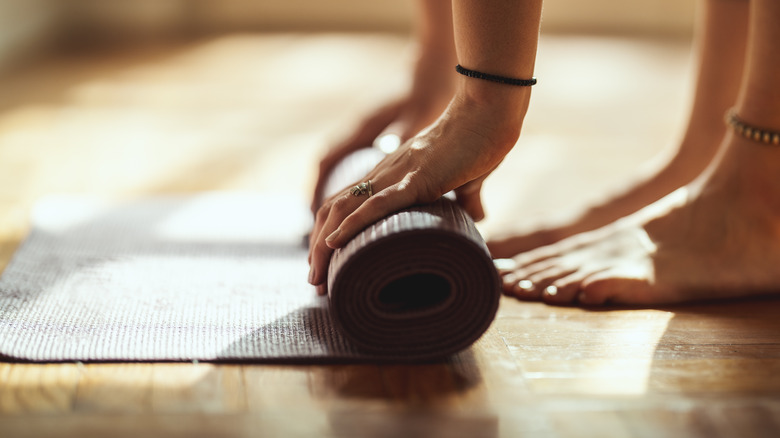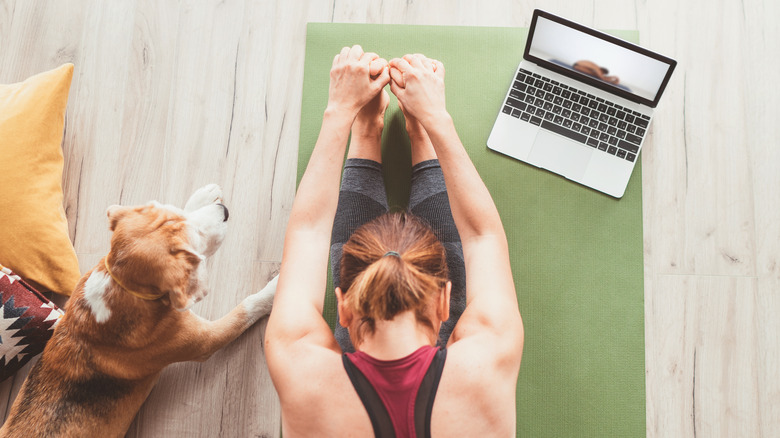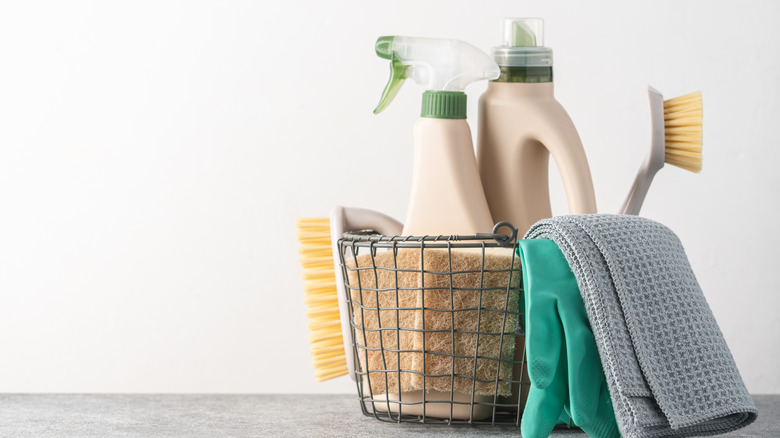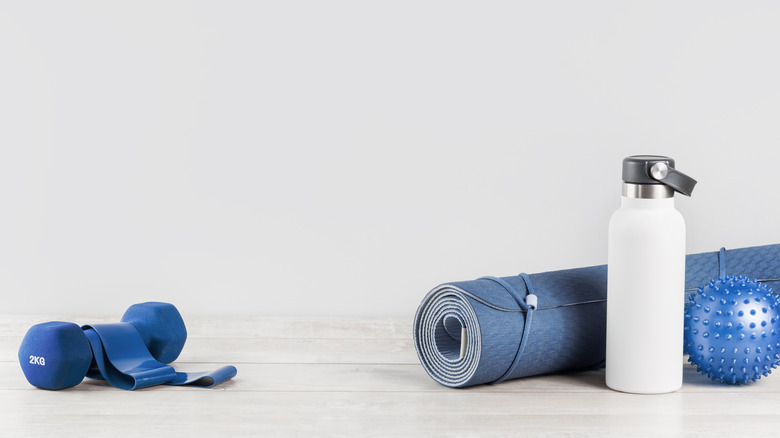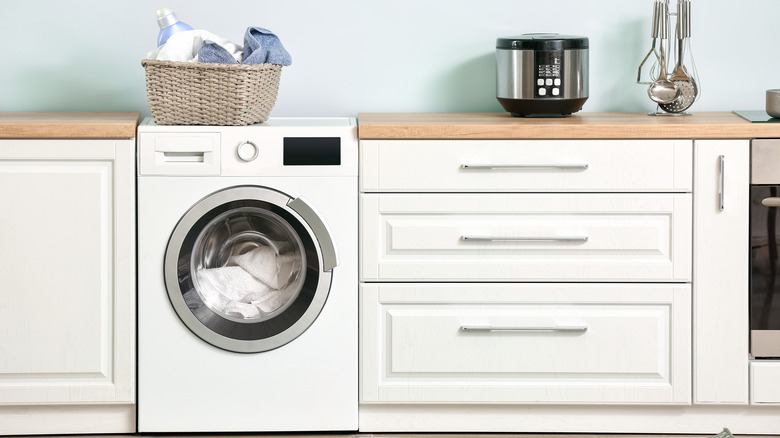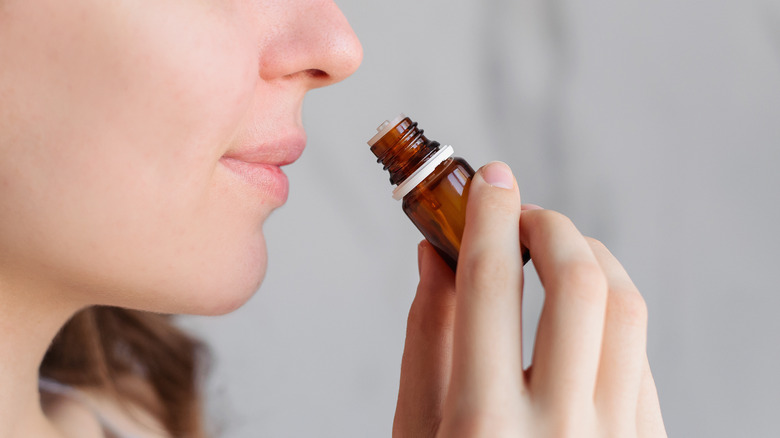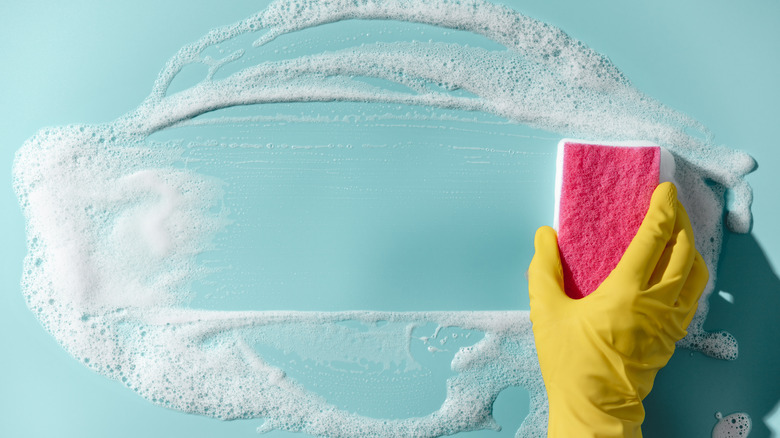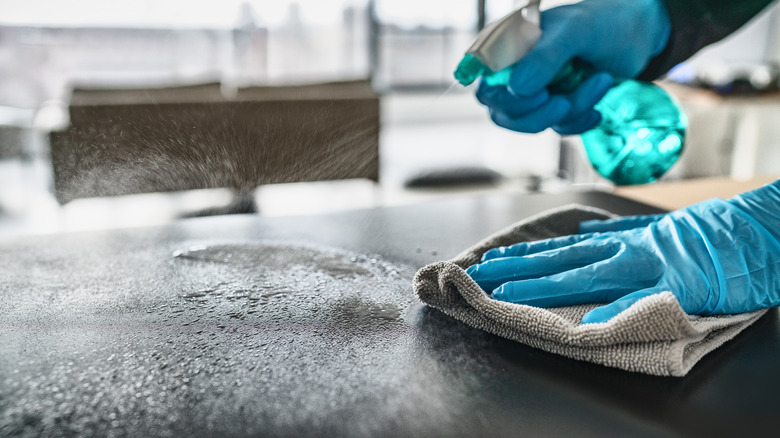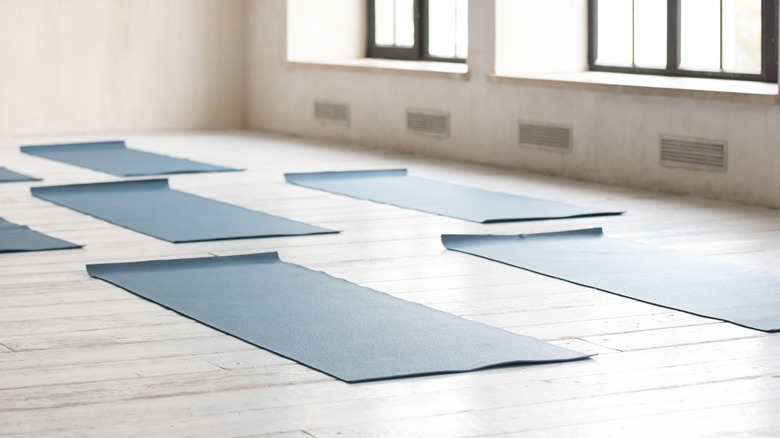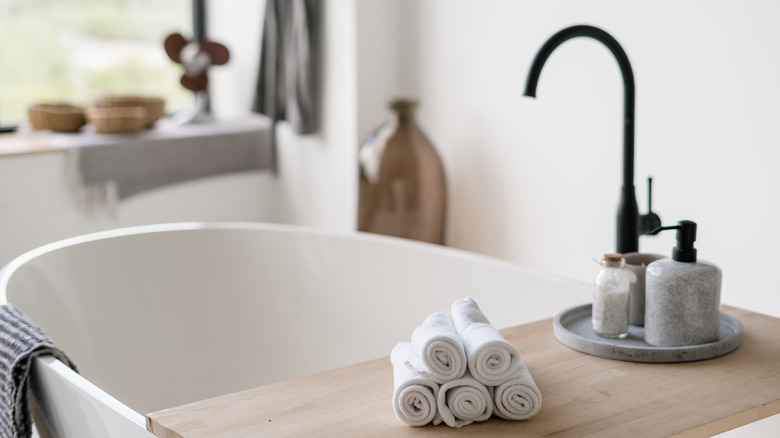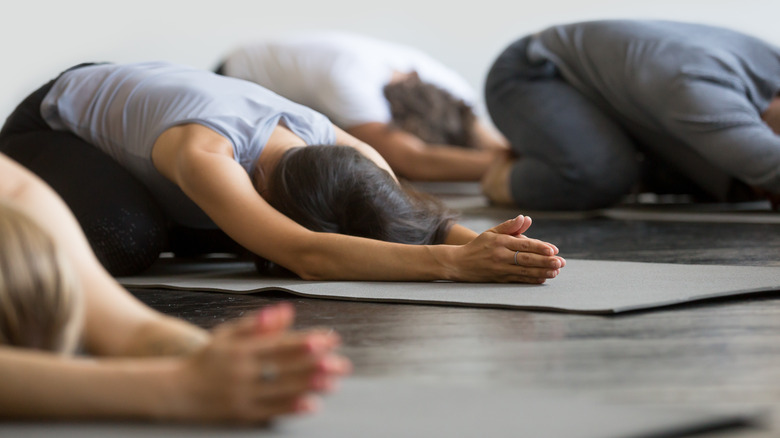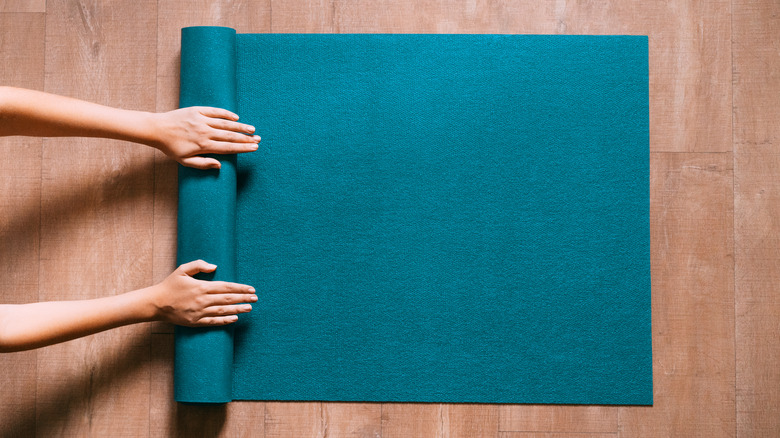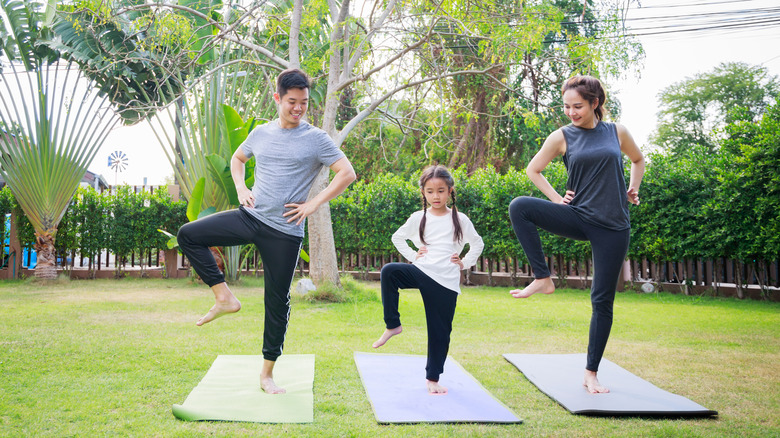How You Should Really Be Cleaning Your Yoga Mat
There are many benefits of practicing yoga for your mind, body, and soul. However, do you ever wonder if your yoga equipment is getting the proper care? Your yoga mat may be dirty if you're not cleaning it regularly. You're likely practicing yoga for your overall health and wellness, but using a dirty mat can harm your health as you work out.
Dirty workout equipment and materials are more common than you may think. FitRated reports that a gym exercise bike has 39 times more germs than a reusable cafeteria tray. Free weights usually have 362 times more bacteria than a toilet seat, and treadmills have 74 times more bacteria than a water faucet handle. Gross, right? While that may be astounding to hear, the truth is that your yoga mat is likely crawling with bacteria, too, if you're not cleaning it regularly and correctly. Thankfully, there are many things you can do to eradicate the gunk and make your yoga mat just as healthy as the workout during your next yoga session.
Why you need to clean your yoga mat
Keeping your yoga mat germ-free for your health is the number one reason to keep it clean. Livestrong provides a good overview of why you should give your yoga mat a good cleaning. First, bacteria on your yoga mat can lead to a skin infection. For instance, fungi that lead to athlete's foot or ringworm can come from a germy yoga mat. Additionally, staph bacteria that enter a cut or wound can cause painful infections on the skin and even bone infections that cause further illness. Human papillomavirus (HPV) is another skin infection you can contract from a dirty yoga mat, leading to skin or plantar warts on your feet.
Second, a yucky yoga mat may spur pesky skin breakouts. Oil, dirt, and dead skin cells coexist with bacteria on a dirty yoga mat. When these get into your skin, they'll block pores and lead to unwanted acne. Finally, your dirty yoga mat can cause you to get sick with something like a common cold, cough, or undesirable stomach flu. Germs that lead to these viruses can quickly settle on surfaces like a yoga mat and survive for days if not properly disinfected.
How dirty is my yoga mat and how does it get that way?
You may be surprised to learn just how dirty your yoga mat really is. Wipex explains that humans shed between 30,000 and 40,000 skin cells every day. In addition, oil and sweat from the body transfer to your yoga mat with each use.
That, combined with the fact that germs and microbes survive best in hot and humid conditions, means that your yoga mat is likely pretty gross — even after a single use! Plus, these microbes multiply rapidly in hot environments. If you're a hot yoga lover, your mat is getting even germier than during a typical session. Even if your yoga mat doesn't look dirty, you're transferring germs from your body with every use. This fact may be something you've never thought of, but it's unfortunately true — and it means that your mat is pretty darn dirty.
How often it should be cleaned
Another element of yoga mat cleaning that may surprise you is how often you need to clean it to keep it in tip-top condition. According to The Maids, you should clean your yoga mat once a month. However, you may want to do it even more than that. A study found that from nearly 300 swabs taken from surfaces around different fitness facilities, more bacteria were present on communal items like weights than on bathroom surfaces and door handles (via National Library of Medicine). Yikes!
To avoid getting sick, scrub and disinfect surfaces to severely reduce your risk of illness (via Martha Stewart). This tip is particularly true for cleaning surfaces where droplets frequently land. You can refresh your yoga mat with a spray cleaner or wipe, or you can choose to fully submerge it in warm, soapy water and scrub it for a deeper clean.
Supplies to use for your yoga mat cleaning
You'll need to have a few supplies in your arsenal to clean your yoga mat successfully. According to Wipex, there are several different things you'll need to get your yoga mat germ-free. Use an absorbent cloth to prevent your mat from becoming slippery after cleaning. A paper towel or a regular towel is best for this. You can also use a laundry detergent or dish soap diluted with water to get the job done. If you'd prefer to go for a wipe or cleanser specifically designated for yoga mats, those definitely exist and also work well.
For whatever cleaner you opt for, you'll likely be getting up close and personal with your yoga mat again soon, so make sure the scent is something you don't mind breathing in (via The Inventory). It's essential to let your yoga mat thoroughly dry before using it again, so make sure that you have the time to allow for that after cleaning (via Food52).
Can I throw my yoga mat in the washing machine?
Want to know if you can conveniently throw your yoga mat in the washing machine to get it clean? That sounds convenient, doesn't it!? Lucky for you, Girl in Paradise on YouTube has a guide showing you how to do this safely. To sum it up, put your yoga mat in your washing machine by itself. Instead of using detergent, use a generous serving of gentle dish soap in the washing machine. Set the machine to medium heat on one of your rapid settings.
Once the wash cycle is complete, don't put the yoga mat in the dryer. Instead, take it out of the washing machine and hang it up to dry. If you can hang it outside in the fresh air, that's ideal. Regardless of where you put it, ensure the mat dries completely before using it again. This tip is a perfect option for deep cleaning and sanitization.
Making your own yoga mat cleaner
A great, all-natural way to clean your yoga mat is by whipping up your own cleaning solution. According to REI, this is pretty simple to do. A well-concocted DIY cleaner will do an excellent job removing dirt, grime, and bacteria from your yoga mat. Just check the care instructions on your mat since there are some things you should never clean with vinegar. To make an effective cleaning solution, you'll need a spray bottle, white vinegar or witch hazel, and some essential oils if you want to use them.
First, mix the vinegar or witch hazel together in a spray bottle. This mixture should be in a one to four ratio. A simple calculation for this is one cup of white vinegar or witch hazel to four cups of water. Then, add two to four drops of your essential oil, depending on how fragrant you want the solution. A good choice for an essential oil is tea tree. Not only does it smell great, but it also features antimicrobial properties. Once you've combined the elixir, replace the cap on the spray bottle and shake it to mix the liquids. You can use this spray to wipe down your yoga mat, applying it liberally. Then, allow the mat to dry for 12 hours before using it again or rolling it up.
Benefits of using essential oils on your yoga mat
Essential oils are perfect for cleaning your yoga mat, especially when added to a DIY cleanser. These oils come with a range of benefits and make mats germ-free. According to Azulfit, there are specific reasons and benefits to using these oils on your mat. First, lavender has many promising properties. It's known for decreasing stress and anxiety. This fact makes it a no-brainer choice for restorative yoga practices. Besides adding lavender to your homemade cleaning solution, you may want to apply it to your feet and wrists for an even more serene yoga experience.
Wild orange is another essential oil to use in your yoga cleaner. It's known for energizing, making it a perfect choice for more high-energy yoga practices. Hello, invigoration! Finally, as mentioned above, tea tree fits nicely with yoga. It has antimicrobial, antiviral, and anti-fungal properties and smells fresh and clean. It's another scent worth enjoying.
The best commercial cleaners for a yoga mat
If you're looking to use commercial cleaners on your yoga mat, you have options! Yoga Journal provides a rundown of reliable, commercial cleaners to use with your yoga mat. Asutra is a biodegradable spray cleaner that uses organic ingredients. Conveniently non-toxic, it doesn't leave a slippery residue but does a great job sanitizing your mat. The scent is light and contains natural essential oils.
Another solid choice is Manduka Organic Yoga Mat Cleaner. It is suited for daily use and features essential oils with a lavender fragrance. The vegetable oil-based surfactant makes this ideal for deep cleaning your yoga mat, but the solution is phosphate-free and doesn't leave a pesky residue. Mind Over Lather Natural Yoga Mat Spray cleaner is another non-toxic option that features natural ingredients and is devoid of alcohol. Since using sprays with alcohol can dry your mat out, this is a good thing! But rest assured, this spray is antibacterial and antiviral. Another selling point of this spray is that it can freshen up other fibers within your home, including furniture or other linens.
Are wipes effective for cleaning a yoga mat?
Another potentially simple way to clean your yoga mat that people gravitate towards is cleaning with disinfectant wipes. After all, wipes are one of the simplest ways to clean, and they work for exercise equipment and areas around your home. So it only makes sense that they could be the perfect way to clean your yoga mat, right?
According to Best in Yoga, it's perfectly safe to use even heavy-duty cleaning wipes to sanitize your yoga mat, particularly Lysol wipes. There is a caveat to using these, though. You need to make sure that your yoga mat cell construction is closed rather than open. Open-cell yoga mats are more porous, meaning it's not safe to use heavy-duty cleaning wipes for them. However, if your yoga mat is of the closed-cell variety, feel free to use a convenient wipe for a quick clean-off. These wipes are highly effective at killing germs and bacteria, and they're available in many pleasant scents, making it easy to choose one that works for your overall preferences.
When and how to spot clean your yoga mat
Spot cleaning your yoga mat is an essential part of regular maintenance. Steam cleaning is a lovely and effective way to do this. As Best in Yoga reports, steam cleaning your yoga mat is simple! Since steam has such a high temperature, it's more effective in killing germs that cause illness and odors that can get locked into your yoga mat after repeated use. Furthermore, it dissolves dirt and debris that can burrow deep into the porous surface of a yoga mat.
For this method of cleaning, you'll need a steam cleaner. This item is an investment, but it's a good choice. First of all, steam cleaners don't need soap or other chemicals like most cleaning methods, which can help save you money over time. You can use them to clean other fibers and surfaces within your home. Finally, steam cleaners are simple to use, allowing you to eradicate germs, odors, and stains. Steam also dries quicker than water, which is another benefit of going this route.
When and how to deep clean your yoga mat
Deep cleaning your yoga mat doesn't need to happen every day, but it's essential to do it regularly. This process will unleash germs from deep in your mat, allowing you to rest easy that you've gotten all the grime out. Best in Yoga provides a great tutorial on deep cleaning your yoga mat in the bathtub. Before doing this, check the instructions on your yoga mat to ensure you're not doing anything that will damage it during the cleaning process.
To deep clean your yoga mat in the tub, fill it with enough water to completely cover. The temperature of the water should be cool to the touch. Next, add your cleaning agent of choice to the tub. Now, allow your mat to soak for 15 to 30 minutes. This step will soften stains and work to break down stubborn dirt and grime. If you find that your mat is still smelly, sprinkle some baking soda into the water to help eradicate the odor. Drain the tub and wipe the surface of your yoga mat with a damp cloth. Now is the time to gently scrub away stains. You may want to use a soft brush, but don't be too aggressive. You don't want to scratch your mat. Now, run water into the tub again to rinse and remove any remaining soap, cleaner, or detergent. Just like that, your yoga mat will be clean as a whistle!
Open cell vs. closed cell yoga mats
Cleaning an open-cell versus a closed-cell mat calls for some differences in the process. But what are the differences between these types of mats? According to Aeromats, closed-cell mats typically feature surface designs, making them more grippy during use. These mats are easy to keep clean since you can wipe them down without worrying that cleaning products will seep into the cells and harm the material. However, a downside to closed-cell mats is that they can become slippery if you sweat on them.
On the other hand, open-cell mats are more porous and open. This feature means you'll be less susceptible to slipping when using this mat. To clean these, you'll need to be less liberal with cleaning products since liquid that gets trapped in the cells won't easily come out. Try dabbing this mat with a damp cloth rather than spraying the cleaning solution or using a wet wipe. Never submerge it in water! Since you can't clean open-cell mats as deeply, they'll need to be replaced more frequently than their counterpart mats.
Yoga mat best practices to keep it germ-free
To keep your yoga mat germ-free, stick to a few simple habits. For example, only step on or use your mat with clean feet and hands, and wipe it down after each use. Always keep it in a dry location between workouts.
According to Verywell Fit, a great hack to keep your yoga mat in pristine condition is to pay attention to how you roll it up. Start by laying your mat flat, then loosely folding it over. This step should make the top side one to two inches shorter than the bottom of the mat. This difference means the top surface is smack in the middle. At this step, avoid creasing the folded end, and don't worry if there are a couple of inches of air bubbles there. Beginning from the loosely folded end, start rolling up your mat. Continue this process until it's rolled completely. There should be a small end piece where the mat is in the open. Most of the surface area will remain clean and germ-free.
How to tell if it's time for a new yoga mat
At a certain point, it's time to throw in the towel on your current mat and invest in a new one. The time comes for every yogi to grab a new mat, so it's good to know when that time rolls around. Verywell Fit offers a handy guide on how often you should kick your old to the curb in favor of a new and shiny one. There are some tell-tale signs yours is ready for a replacement. The first one is if there's a lingering smell. The next is if your mat feels suspiciously thin, particularly around the ends where your hands and feet touch the most.
Another sign is if you start to find that you're slipping around when practicing yoga on your mat. Finally, if your yoga mat is looking worse for wear with pieces peeling off, it's time to invest in a new one. The lifespan depends on many different factors, so evaluating these signs is your best bet for understanding that it's time to pull the plug on your current mat.
